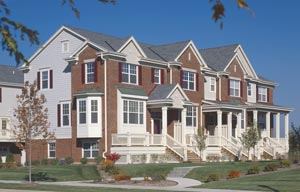Know Your Buyer It’s likely that you already know your buyer, especially if you cater to the under-30 crowd. These young buyers place a lot of value on location so they may want to buy a townhouse or a condo in the same general area where they rent.
If the area under consideration for a new project was a good location for apartments, Cross says that’s an indicator the location also will attract multifamily buyers. However, it is key that the location be in close proximity to shopping, employment, and public transportation.
Cross warns about pricing for-sale product out of range for your buyers. Let’s say your typical renters lease units for $1,000 per month and make about $40,000 per year in income. If you’re trying to attract the same market with condos priced at $175,000, the income requirement to get a loan at this amount jumps to $60,000 per year – and also assumes they’ll have the $20,000 down payment.
Some young people won’t see the immediate benefits of homeownership if they can’t buy something that’s at least comparable in price to their rental unit.
Amenity packages still rate as a priority for attracting buyers, but they’re not as important to buyers as they are to renters. Multifamily buyers prefer reasonable homeowners association dues to extravagant amenities. So, developers may have to think smaller and incorporate amenities that appear more practical than flashy.
A variety of people can co-exist happily in one rental community, but their different needs become more significant when designing and developing for-sale product. Empty-nesters need master bedrooms on the first floor, if applicable, and lots of storage. Baby boomers and Gen-Xers want modern designs, such as lofts, with unique features. Gen-Yers tend to be price sensitive and appreciate smaller units with features such as wood floors and granite countertops.
Design Considerations The for-sale market is competitive. Renters won’t pay $20 more per month for the same special design features that buyers eagerly add $1,000 to their sales price. Buyers tend to spend extra on options that make their homes distinctive, such as French doors to a den, a functional kitchen with an island, and fireplaces. Buyers in this market don’t need extravagances – they just want to have choices.
It’s key to be able to provide a variety of plan types in a given module in order to satisfy buyer demands at any moment. You can create a flat-over-flat product that can be substituted for a townhouse plan within the same footprint. This interchangeability allows a developer to anticipate buyers’ needs and offer exactly what they want without having to go back to the local planning commission to get approval for new plans. The density of the project remains the same: the buyer profile for the unit is the only thing that changes. For-sale developers have an advantage over rental developers in that they may change their product offerings midstream to attract more buyers, while rental developers are usually locked into their original product.
Renters will often lease a unit based purely on function and utility, but buyers may have desires that aren’t readily apparent. A 28-year-old single woman may be perfectly happy renting a one-bedroom apartment but when she buys a home, she may want two bedrooms because she sees herself getting married. So it’s important to anticipate the position of buyers on the life cycle and how their position may change while they’re living in a home.
In general, buyers will want larger square footages and higher bedroom counts than what a rental developer is used to building. Rental developments tend to offer more one- and two-bedroom units while buyers will likely prefer a for-sale unit with three bedrooms so they can use the extra rooms for a home office or a nursery.
It also is important to incorporate utility space into designs, adds Cross. He says that for-sale units are 10 percent larger than rental units to allow for utility space and storage. Renters don’t usually require as much storage because many are just starting out and haven’t accumulated things. However, buyers see a home, and therefore want and need a place to put all their belongings. Therefore, designs must include closets that appear larger and more functional.
Noise also can be an issue in a for-sale community, where it isn’t an issue for renters. After all, renters could always move at the end of their lease if the neighbors upstairs are too noisy.
Finally, for-sale projects require a large commitment to merchandising models. Buyers want to see a fully decorated model for each plan so they can get some decorating tips and furniture placement ideas, leaving the model with a clearer vision of what their lives will be like in their new homes.
–Doug Buster is managing partner of Bloodgood Sharp Buster Architects and Planners in Chicago.
